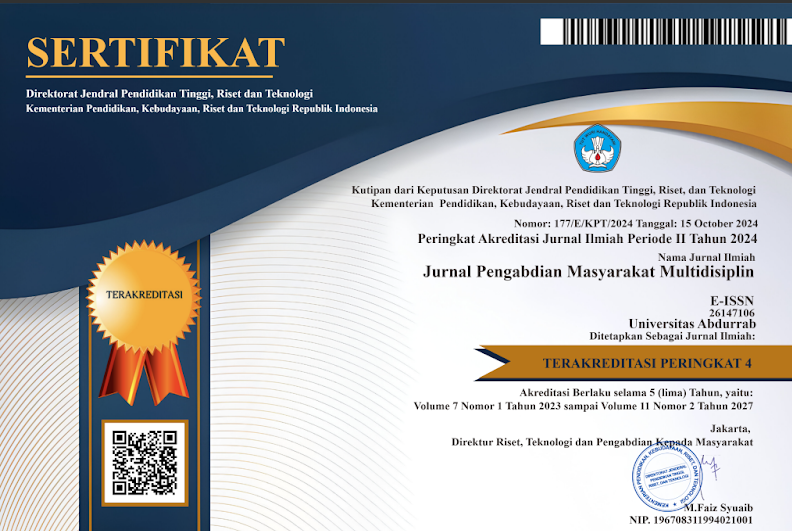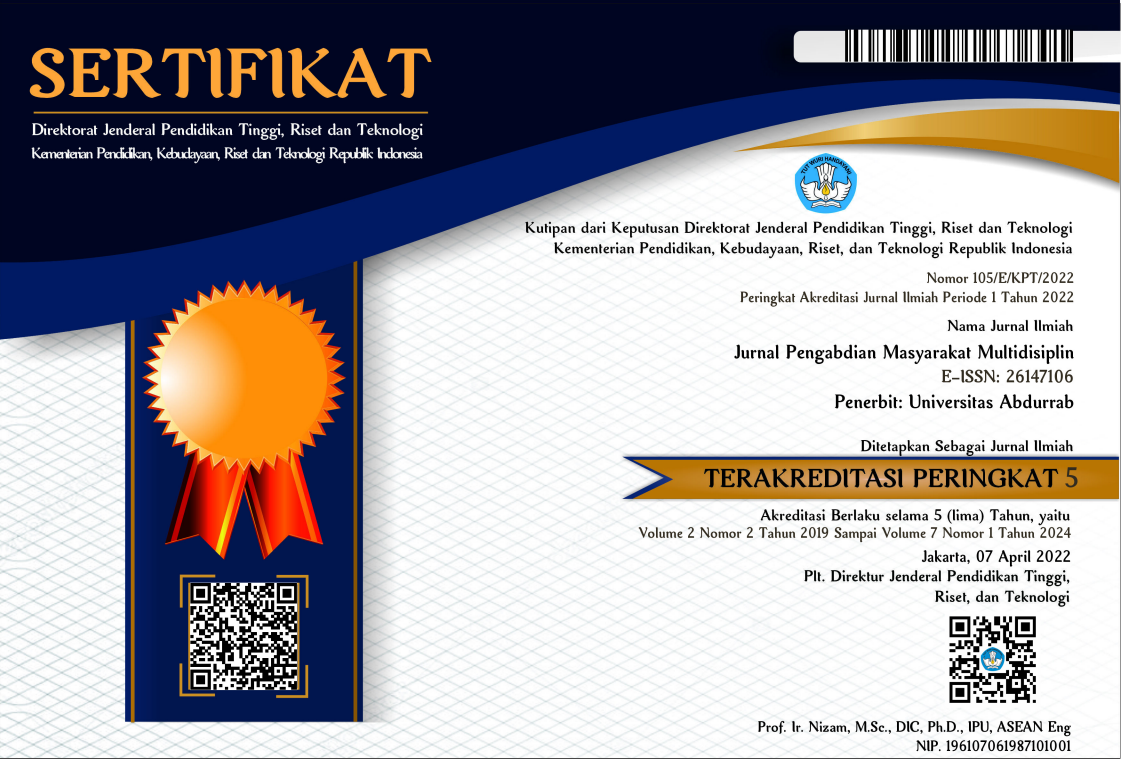PENYULUHAN UPAYA PENCEGAHAN & PENGENDALIAN NYERI PADA PESEPEDA
DOI:
https://doi.org/10.36341/jpm.v7i1.3335Kata Kunci:
Pain, Exercise, Injury RiskAbstrak
Since the beginning of the COVID-19 pandemic until now, people's lifestyles have experienced changes in the aspects of work, hobbies, lifestyle, education and health. Sports have become a popular hobby activity during the pandemic. In addition to maintaining health and fitness, the benefits of exercise are also to reduce stress and socialize. When there was a pandemic and 'social restrictions' were imposed on the Jabodetabek area, a phenomenon occurred, people were happy and interested in cycling. The use of bicycles increased by 1000 percent during these restrictions in Jabodetabek. However, the increased use of bicycles has not been matched by an understanding of the risk factors for oozing injuries that cause musculoskeletal pain which results in impaired movement function. This unexpected musculoskeletal pain can interfere with daily productivity so that it can reduce the individual's quality of life. Counseling on preventing musculoskeletal pain in cyclists is important so that partners can apply steps and techniques to prevent injuries and optimize the fitness benefits of cycling. This service aims to organize counseling for cyclists on preventive measures at home so as to reduce the incidence of pain. The dedication partner is the Purnakarya Tangerang bicycle community. Activities in the form of counseling on risk factors, providing preventive measures before, during and after cycling and strategies for optimizing cycling fitness levels. The output of the activity is that partners can manage risk factors, preventative measures, and optimize the fitness benefits of cycling
Unduhan
Referensi
T. Götschi, J. Garrard, and B. Giles-Corti, “Cycling as a Part of Daily Life: A Review of Health Perspectives,†Transp. Rev., vol. 36, no. 1, pp. 45–71, 2016, doi: 10.1080/01441647.2015.1057877.
A. Zander, E. Passmore, C. Mason, and C. Rissel, “Joy, exercise, enjoyment, getting out: A qualitative study of older people’s experience of cycling in Sydney, Australia,†J. Environ. Public Health, vol. 2013, 2013, doi: 10.1155/2013/547453.
A. C. Lusk, R. A. Mekary, D. Feskanich, and W. C. Willett, “Bicycle riding, walking, and weight gain in premenopausal women,†Arch. Intern. Med., vol. 170, no. 12, pp. 1050–1056, 2010, doi: 10.1001/archinternmed.2010.171.
M. p. Hoevenaar-Blom, gc W. Wendel-Vos, A. M. Spijkerman, D. Kromhout, and W. Verschuren, “Cycling and sports, but not walking, are associated with 10-year cardiovascular disease incidence: The MORGEN Study,†Eur. J. Prev. Cardiol., vol. 18, no. 1, pp. 41–47, 2011, doi: 10.1097/HJR.0b013e32833bfc87.
D. Rooney, I. Sarriegui, and N. Heron, “‘As easy as riding a bike’: A systematic review of injuries and illness in road cycling,†BMJ Open Sport Exerc. Med., vol. 6, no. 1, pp. 1–9, 2020, doi: 10.1136/bmjsem-2020-000840.
I. S. Fulmer and J. Li, “Compensation, Benefits, and Total Rewards: A Bird’s-Eye (Re)View,†Annu. Rev. Organ. Psychol. Organ. Behav., vol. 9, no. 1, pp. 147–169, 2022, doi: 10.1146/annurev-orgpsych-012420-055903.
K. J, “Severe Musculoskeletal Injuries due to the use of Cleats Whilst Cycling,†Int. J. Sport. Exerc. Med., vol. 1, no. 4, pp. 1–4, 2015, doi: 10.23937/2469-5718/1510019.
J. Van Cauwenberg et al., “Environmental influences on older adults’ transportation cycling experiences: A study using bike-along interviews,†Landsc. Urban Plan., vol. 169, no. April 2017, pp. 37–46, 2018, doi: 10.1016/j.landurbplan.2017.08.003.
R. CANIVEL and F. Wyatt, “Cardiovascular Responses Between Low Cadence/High Force vs. High Cadence/Low Force Cycling,†Int. J. Exerc. Sci., vol. 9, no. 4, p. 4, 2016.
I. M. Saadeh and T. S. Suifan, “Job stress and organizational commitment in hospitals,†Int. J. Organ. Anal., vol. 28, no. 1, pp. 226–242, Jan. 2020, doi: 10.1108/IJOA-11-2018-1597.
B. R. Tole, “Benefits of cyling for elders,†vol. 10, no. 8, pp. 736–740, 2022.
F. P. Rivara, D. C. Thompson, and R. S. Thompson, “Epidemiology of bicycle injuries and risk factors for serious injury,†Inj. Prev., vol. 21, no. 1, pp. 47–51, 2015, doi: 10.1136/injprev-00002-0038rep.
J. I. Priego Quesada, Z. Y. Kerr, W. M. Bertucci, and F. P. Carpes, “A retrospective international study on factors associated with injury, discomfort and pain perception among cyclists,†PLoS One, vol. 14, no. 1, pp. 1–16, 2019, doi: 10.1371/journal.pone.0211197.
S. Le Douairon Lahaye et al., “Impact of long-lasting moderate-intensity stage cycling event on cardiac function in young female athletes: A case study,†PLoS One, vol. 17, no. 10 October, pp. 1–12, 2022, doi: 10.1371/journal.pone.0275332.
L. McGuire and N. Smith, “Cycling safety: Injury prevention in Oxford cyclists,†Inj. Prev., vol. 6, no. 4, pp. 285–287, 2000, doi: 10.1136/ip.6.4.285.
H. M. Siebentritt et al., “Safer cycling in older age (SiFAr): a protocol of a randomized controlled trial,†BMC Geriatr., vol. 21, no. 1, pp. 1–11, 2021, doi: 10.1186/s12877-021-02502-5.
J. Kukadia, G. Zamfir, G. Arealis, N. Ashwood, and B. Karagkevrekis, “ClinMed,†pp. 1–4, 2015.
##submission.downloads##
Diterbitkan
Cara Mengutip
Terbitan
Bagian
Lisensi
1. Copyright of all journal manuscripts is held by the Jurnal Pengabdian Masyarakat Multidisiplin.Formal legal provisions to access digital articles of electronic journal are subject to the provision of the Creative
2. Commons Attribution-ShareAlike license (CC BY-NC-SA), which means that Jurnal Pengabdian Masyarakat Multidisiplin is rightful to keep, transfer media/format, manage in the form of databases, maintain, and
3. publish articles.Published manuscripts both printed and electronic are open access for educational, research, and library purposes. Additionally, the editorial board is not responsible for any violations of copyright law.
licensed under a Creative Commons Attribution-ShareAlike 4.0 International License.







